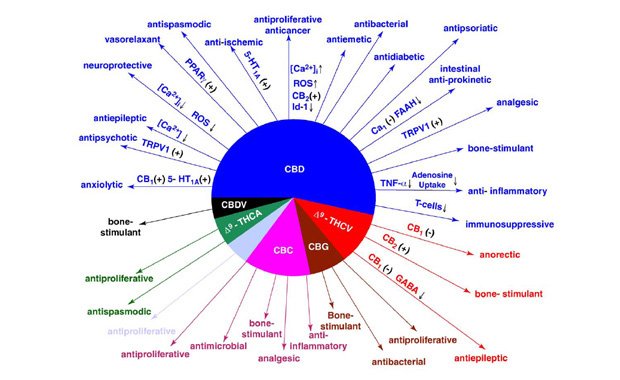CBD is one of over 85+ compounds found in cannabis that belong to a class of molecules called cannabinoids.
Of these compounds, CBD and THC are usually present in the highest concentrations, and are therefore the most recognized and studied. We at CBD Crew are using cannabis to create our strains, not hemp. All our genetics will have traces of all canabinoids found naturally in the plants genetics, as we believe in the entourage effect of the plant to be the most effective for most patients.
CBD and THC levels tend to vary between different strains and varieties of cannabis. By using selective breeding techniques, we have managed to create varieties with high levels of CBD and THC.
CBD does not cause a high, unlike THC. The reason why CBD is non-psychoactive is due to its lack of affinity for CB1 receptors. CB1 receptors are found in high concentrations in the brain, and are the pathways responsible for the psychoactive effects of THC.
Here is a short video that explains the benefits of CBD:
CBD Chemical data:
Formula: C21H30O2
Mol. mass: 314.46

Cannabidiol (CBD) is one of the main cannabinoids present in the naturally growing populations and in the industrially cultivated varieties of Cannabis sativa L. CBD its not psychoactive and has several pharmacological properties, among others it acts as a powerful anti-inflammatory and antioxidant compound.
Cannabis sativa L. has been selectively bred for recreational uses to obtain the maximum “high”, so the level of delta-9-tetrahydrocannabinol (THC) have been increased very much (up to 20-25%) and, in upping the potency through selective breeding, CBD has been selectively eliminated from recreational varieties or, eventually, it is rarely found in specific varieties. CBD is often found in hemp – in varieties used to produce fiber and seeds. But the combination of CBD/THC in cannabis seem to be beneficial for medical use.
The isolation of CBD was recorded back on 1940 by two independent investigation groups. The group of Adams and colleges successfully isolated it from marihuana 1. At the same time Jacob and Todd successfully isolated the cannabidiol from indian hemp resin 2. But was not until 1963 that Mechoulam and Shyo discovered the chemical structure of the CBD and enlightening the comprehension of the nature of the cannabinoids 3. At the next year 1964 Gaoni and Mechoulam finally elucidated the chemical structure of the main psychoactive compound of cannabis the THC matching the starting point of the modern pharmacology of cannabis 4.
1 B R. Adams, M. Hunt and J. H. Clark, J. Amer. Gem. Sot. 62,196 (1940).
2 A. Jacob and A. R. Todd, J. Gem. Sot. 649 (1940)
3 Mechoulam R, Shvo Y. Hashish. I. The structure of cannabidiol. Tetrahedron. 19: 2073 (1963).
 Project CBD, a California based non-profit educational service dedicated to promoting and publicizing research into the medical utility of cannabidiol (CBD) provides us with this definition:
Project CBD, a California based non-profit educational service dedicated to promoting and publicizing research into the medical utility of cannabidiol (CBD) provides us with this definition:
Cannabidiol —CBD— is a compound in Cannabis that has medical effects but does not make people feel “stoned” and actually counters some of the effects of THC. After decades in which only high-THC Cannabis was available, CBD-rich strains are now being grown by and for medical users.
The reduced psychoactivity of CBD-rich Cannabis may make it an appealing treatment option for patients seeking anti-inflammatory, anti-pain, anti-anxiety and/or anti-spasm effects without disconcerting euphoria or lethargy.
Scientific and clinical studies indicate that CBD could be effective in easing symptoms of a wide range of difficult-to-control conditions, including: rheumatoid arthritis, diabetes, alcoholism, PTSD, epilepsy, antibiotic-resistant infections and neurological disorders. CBD has demonstrated neuroprotective effects, and its anti-cancer potential is currently being explored at several academic research centers in the U.S. and other countries.

Scientific references:
- Cannabis is more than simply delta9-tetrahydrocannabinol
Ethan B. Russo · John M. McPartland
http://www.omma1998.org/Psychopharmacology-Russo-McPartland.pdf
Published online: 19 December 2002
Springer-Verlag 2002 - Non-psychotropic plant cannabinoids: new therapeutic opportunities from an ancient herb
Angelo A. Izzo, Francesca Borrelli, Raffaele Capasso, Vincenzo Di Marzo and Raphael Mechoulam
http://www.ncbi.nlm.nih.gov/pubmed/19729208
Org. Biomol. Chem., 2005, 3, 1116 – 1123 - Cannabinoids: potential anticancer agents.
Nat Rev Cancer. 2003 Oct; 3(10):745-55.
Guzmán Manuel, Department of Biochemistry and Molecular Biology I, School of Biology,
Complutense University, 28040 Madrid, Spain - Enantiomeric cannabidiol derivatives: synthesis and binding to cannabinoid receptors
Lumír O. Hanu, Susanna Tchilibon, Datta E. Ponde, Aviva Breuer,
Ester Fride and Raphael Mechoulam
http://www.ncbi.nlm.nih.gov/pubmed/15750656 - Cannabidiol: from an inactive cannabinoid to a drug with wide spectrum of action
Antonio Waldo Zuardi
Department of Neurology, Psychiatry and Medical Psychology,
Faculdade de Medicina de Ribeirão Preto, Universidade de São Paulo (USP), Brazil
http://bit.ly/a3lcSS - MECHOULAM ON CANNABIDIOL
From O’Shaughnessy’s // Winter/Spring 2008

